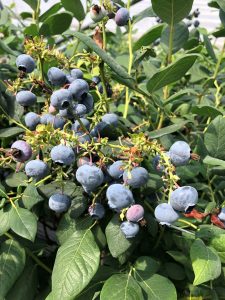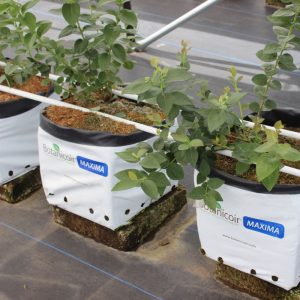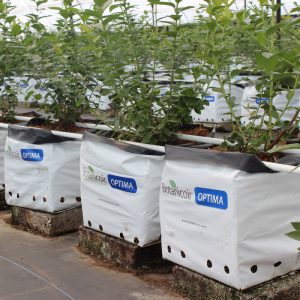In recent years, there have been rapid and large-scale changes in the way that blueberry crops are grown. The increasingly popular berry requires well-draining soils with good levels of organic material and in many areas with ideal climatic conditions and easily available markets, these soil conditions can be hard to find. This has led growers to take the decision to move into substrate growing.
 The benefits of moving blueberry crops into substrate are common to those of many other crops, the most prominent being the freedom from soil-borne pests and diseases; control over the aeration, moisture and nutrition for the plant; and the increased flexibility to replace poorly performing plants and change varieties more efficiently.
The benefits of moving blueberry crops into substrate are common to those of many other crops, the most prominent being the freedom from soil-borne pests and diseases; control over the aeration, moisture and nutrition for the plant; and the increased flexibility to replace poorly performing plants and change varieties more efficiently.
There are many options available to growers looking to move their crops into substrate, from the size of growing container and whether to repot later in the crop, to the shape and colour of the container and of course which type of growing media to use.
Most growers receive their plants from the nursery in 1-2 litre pots and will then repot into larger containers. Some growers initially planting into medium size containers (10-16 litre) at 2-4x density and then after 1-2 years will repot again into large 25-35 litre containers and space out to their final cropping density of around 90cm apart. But these days, most growers will go directly into the large pots. In some cases, after another 3-5 years, growers will re-pot a final time into 45-60 litre pots with the idea being to increase root volume and prolong the productive life of the plant, but this trend is diminishing as it is thought that it is not a cost-efficient option.
 One of the primary concerns when choosing a growing container and the substrate to use, is the freedom of drainage. If drainage is poor in the substrate, or the base of the pot does not allow for sufficient drainage, it could be a serious cause of root dieback. For rigid pots, it is recommended that they have ample drainage holes and pronounced legs to prevent the drainage holes from being blocked. If poly-pot containers are used (often referred to as Open Top Containers, or OTC’s), then they should be raised off the ground, for example by using tiles or wood battens.
One of the primary concerns when choosing a growing container and the substrate to use, is the freedom of drainage. If drainage is poor in the substrate, or the base of the pot does not allow for sufficient drainage, it could be a serious cause of root dieback. For rigid pots, it is recommended that they have ample drainage holes and pronounced legs to prevent the drainage holes from being blocked. If poly-pot containers are used (often referred to as Open Top Containers, or OTC’s), then they should be raised off the ground, for example by using tiles or wood battens.
In recent years, many growers have started to move over to 100% coir substrates for their blueberry crops, which would generally be a mix of coir pith, short cut fibre and 5-7mm chips. The nature of coir means that during the production process it can be sieved to remove all of the fine dust particles (<1mm) and therefore encouraging better root development and a free draining environment. The high lignin content offers a more stable and long-term structure, which is crucial in crops with long productive lives, such as blueberries. And in a more practical sense, coir can be dried and compressed, offering big savings in transport, storage and handling.
 “The most popular product we produce for blueberry growers is what we call a “naked block” that comes without plastic and hydrates to 30x30x24cm.” says Kalum Balasuriya, Managing Director at the globally recognised coir manufacturer, Botanicoir, “These blocks are compressed at our facilities and growers can simply put them into their existing pots and hydrate in-situ, avoiding the need for pot-filling and additional handling.”
“The most popular product we produce for blueberry growers is what we call a “naked block” that comes without plastic and hydrates to 30x30x24cm.” says Kalum Balasuriya, Managing Director at the globally recognised coir manufacturer, Botanicoir, “These blocks are compressed at our facilities and growers can simply put them into their existing pots and hydrate in-situ, avoiding the need for pot-filling and additional handling.”
Another alternative is Open Top Containers, or OTC’s, which come ready packed in their own poly-pot and can be unfolded before hydrating the coir block inside. This is a popular option for growers who do not wish to make a large initial investment in the rigid containers.
Chemically, coir substrate does need extra washing and buffering, but all reputable manufacturers will be able to do this as part of the production process. The pH is a little high in coir, but this can be easily managed with a high NH4-N fertigation recipe.
“At Botanicoir we have developed 3 different mixes, called Ultra, Maxima and Optima, to suit grower preferences and climatic requirements for their blueberry crops, with each product offering something different,” says Kalum, “We would always recommend a pre-buffered product, as we can guarantee the uniformity of the buffering during production, but we understand that some growers prefer to do this process themselves as well.”
A lack of uniformity will lead to an uneven growing area and will make crop management much more difficult throughout the season, so uniformity is an important issue when talking about substrate growing and is a question that should be asked of all manufacturers.

